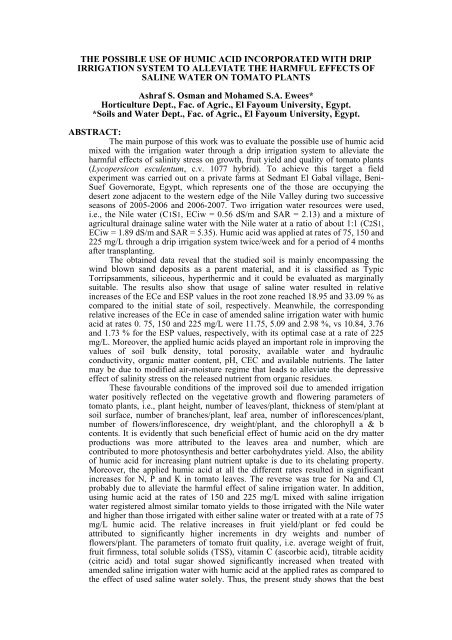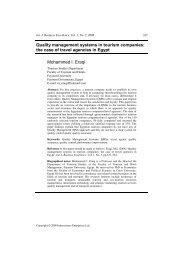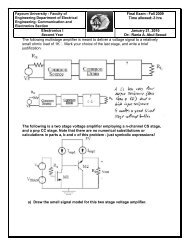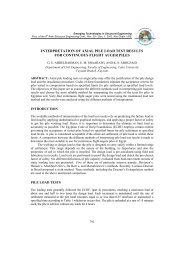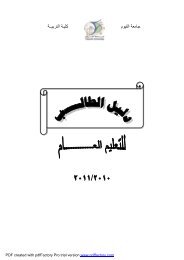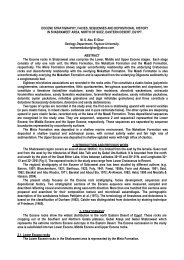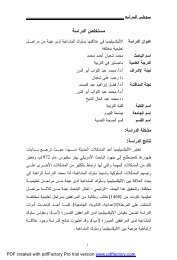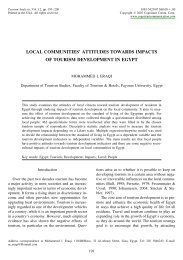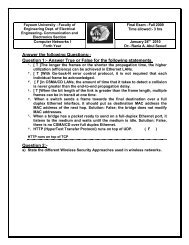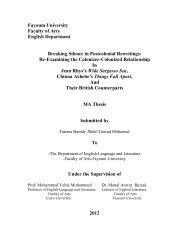the possible use of humic acid incorporated with drip irrigation ...
the possible use of humic acid incorporated with drip irrigation ...
the possible use of humic acid incorporated with drip irrigation ...
You also want an ePaper? Increase the reach of your titles
YUMPU automatically turns print PDFs into web optimized ePapers that Google loves.
THE POSSIBLE USE OF HUMIC ACID INCORPORATED WITH DRIP<br />
IRRIGATION SYSTEM TO ALLEVIATE THE HARMFUL EFFECTS OF<br />
SALINE WATER ON TOMATO PLANTS<br />
Ashraf S. Osman and Mohamed S.A. Ewees*<br />
Horticulture Dept., Fac. <strong>of</strong> Agric., El Fayoum University, Egypt.<br />
*Soils and Water Dept., Fac. <strong>of</strong> Agric., El Fayoum University, Egypt.<br />
ABSTRACT:<br />
The main purpose <strong>of</strong> this work was to evaluate <strong>the</strong> <strong>possible</strong> <strong>use</strong> <strong>of</strong> <strong>humic</strong> <strong>acid</strong><br />
mixed <strong>with</strong> <strong>the</strong> <strong>irrigation</strong> water through a <strong>drip</strong> <strong>irrigation</strong> system to alleviate <strong>the</strong><br />
harmful effects <strong>of</strong> salinity stress on growth, fruit yield and quality <strong>of</strong> tomato plants<br />
(Lycopersicon esculentum, c.v. 1077 hybrid). To achieve this target a field<br />
experiment was carried out on a private farms at Sedmant El Gabal village, Beni-<br />
Suef Governorate, Egypt, which represents one <strong>of</strong> <strong>the</strong> those are occupying <strong>the</strong><br />
desert zone adjacent to <strong>the</strong> western edge <strong>of</strong> <strong>the</strong> Nile Valley during two successive<br />
seasons <strong>of</strong> 2005-2006 and 2006-2007. Two <strong>irrigation</strong> water resources were <strong>use</strong>d,<br />
i.e., <strong>the</strong> Nile water (C1S1, ECiw = 0.56 dS/m and SAR = 2.13) and a mixture <strong>of</strong><br />
agricultural drainage saline water <strong>with</strong> <strong>the</strong> Nile water at a ratio <strong>of</strong> about 1:1 (C2S1,<br />
ECiw = 1.89 dS/m and SAR = 5.35). Humic <strong>acid</strong> was applied at rates <strong>of</strong> 75, 150 and<br />
225 mg/L through a <strong>drip</strong> <strong>irrigation</strong> system twice/week and for a period <strong>of</strong> 4 months<br />
after transplanting.<br />
The obtained data reveal that <strong>the</strong> studied soil is mainly encompassing <strong>the</strong><br />
wind blown sand deposits as a parent material, and it is classified as Typic<br />
Torripsamments, siliceous, hyper<strong>the</strong>rmic and it could be evaluated as marginally<br />
suitable. The results also show that usage <strong>of</strong> saline water resulted in relative<br />
increases <strong>of</strong> <strong>the</strong> ECe and ESP values in <strong>the</strong> root zone reached 18.95 and 33.09 % as<br />
compared to <strong>the</strong> initial state <strong>of</strong> soil, respectively. Meanwhile, <strong>the</strong> corresponding<br />
relative increases <strong>of</strong> <strong>the</strong> ECe in case <strong>of</strong> amended saline <strong>irrigation</strong> water <strong>with</strong> <strong>humic</strong><br />
<strong>acid</strong> at rates 0. 75, 150 and 225 mg/L were 11.75, 5.09 and 2.98 %, vs 10.84, 3.76<br />
and 1.73 % for <strong>the</strong> ESP values, respectively, <strong>with</strong> its optimal case at a rate <strong>of</strong> 225<br />
mg/L. Moreover, <strong>the</strong> applied <strong>humic</strong> <strong>acid</strong>s played an important role in improving <strong>the</strong><br />
values <strong>of</strong> soil bulk density, total porosity, available water and hydraulic<br />
conductivity, organic matter content, pH, CEC and available nutrients. The latter<br />
may be due to modified air-moisture regime that leads to alleviate <strong>the</strong> depressive<br />
effect <strong>of</strong> salinity stress on <strong>the</strong> released nutrient from organic residues.<br />
These favourable conditions <strong>of</strong> <strong>the</strong> improved soil due to amended <strong>irrigation</strong><br />
water positively reflected on <strong>the</strong> vegetative growth and flowering parameters <strong>of</strong><br />
tomato plants, i.e., plant height, number <strong>of</strong> leaves/plant, thickness <strong>of</strong> stem/plant at<br />
soil surface, number <strong>of</strong> branches/plant, leaf area, number <strong>of</strong> inflorescences/plant,<br />
number <strong>of</strong> flowers/inflorescence, dry weight/plant, and <strong>the</strong> chlorophyll a & b<br />
contents. It is evidently that such beneficial effect <strong>of</strong> <strong>humic</strong> <strong>acid</strong> on <strong>the</strong> dry matter<br />
productions was more attributed to <strong>the</strong> leaves area and number, which are<br />
contributed to more photosyn<strong>the</strong>sis and better carbohydrates yield. Also, <strong>the</strong> ability<br />
<strong>of</strong> <strong>humic</strong> <strong>acid</strong> for increasing plant nutrient uptake is due to its chelating property.<br />
Moreover, <strong>the</strong> applied <strong>humic</strong> <strong>acid</strong> at all <strong>the</strong> different rates resulted in significant<br />
increases for N, P and K in tomato leaves. The reverse was true for Na and Cl,<br />
probably due to alleviate <strong>the</strong> harmful effect <strong>of</strong> saline <strong>irrigation</strong> water. In addition,<br />
using <strong>humic</strong> <strong>acid</strong> at <strong>the</strong> rates <strong>of</strong> 150 and 225 mg/L mixed <strong>with</strong> saline <strong>irrigation</strong><br />
water registered almost similar tomato yields to those irrigated <strong>with</strong> <strong>the</strong> Nile water<br />
and higher than those irrigated <strong>with</strong> ei<strong>the</strong>r saline water or treated <strong>with</strong> at a rate <strong>of</strong> 75<br />
mg/L <strong>humic</strong> <strong>acid</strong>. The relative increases in fruit yield/plant or fed could be<br />
attributed to significantly higher increments in dry weights and number <strong>of</strong><br />
flowers/plant. The parameters <strong>of</strong> tomato fruit quality, i.e. average weight <strong>of</strong> fruit,<br />
fruit firmness, total soluble solids (TSS), vitamin C (ascorbic <strong>acid</strong>), titrable <strong>acid</strong>ity<br />
(citric <strong>acid</strong>) and total sugar showed significantly increased when treated <strong>with</strong><br />
amended saline <strong>irrigation</strong> water <strong>with</strong> <strong>humic</strong> <strong>acid</strong> at <strong>the</strong> applied rates as compared to<br />
<strong>the</strong> effect <strong>of</strong> <strong>use</strong>d saline water solely. Thus, <strong>the</strong> present study shows that <strong>the</strong> best
ate <strong>of</strong> <strong>the</strong> applied <strong>humic</strong> <strong>acid</strong> mixed <strong>with</strong> <strong>the</strong> <strong>use</strong>d <strong>irrigation</strong> saline water was 150-<br />
225 mg/L for achieving <strong>the</strong> greatest tomato yield <strong>of</strong> high quality.<br />
Key words: Sandy soil, tomato, <strong>humic</strong> <strong>acid</strong>, <strong>drip</strong> <strong>irrigation</strong> system and saline<br />
<strong>irrigation</strong> water, tomato vegetative growth and fruit quality.


